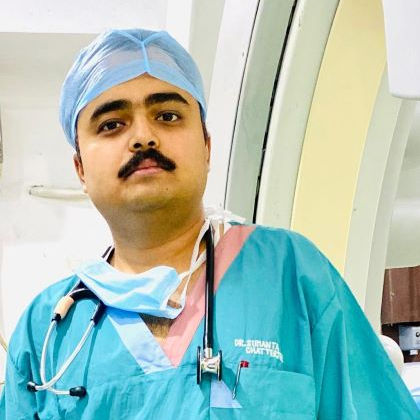CABG Surgery: Everything You Need to Know!
Explore everything you need to know about CABG (Coronary Artery Bypass Grafting) surgery, including the procedure, recovery, risks, and benefits, to understand how it improves heart health and saves lives.

Written by Dr Shreya Sarkar
Last updated on 3rd Jul, 2025
Coronary Artery Bypass Grafting (CABG) surgery is one of the most common and effective treatments for individuals with severe coronary artery disease (CAD). If you or a loved one is facing this procedure, it’s important to understand what CABG is, why it’s necessary, what to expect during recovery, and how it can improve your heart health. This comprehensive guide will walk you through the details of CABG surgery, from preparation to recovery, providing helpful information that will empower you to take control of your heart health.
What is CABG Surgery?
CABG, often referred to as heart bypass surgery, is a procedure designed to restore blood flow to the heart muscle. It is primarily used to treat coronary artery disease, a condition in which the arteries that supply blood to the heart become narrowed or blocked by a buildup of fatty deposits (atherosclerosis). When blood flow to the heart is reduced, the heart muscle may not get enough oxygen, leading to chest pain (angina), shortness of breath, or even heart attacks.
During CABG surgery, a surgeon uses blood vessels from another part of the body (often the chest, leg, or arm) to bypass the blocked or narrowed coronary arteries, creating a new route for blood to flow to the heart muscle. The procedure can involve bypassing one or more arteries, depending on the extent of the disease.
Why is CABG Surgery Necessary?
When a person has severe coronary artery disease, the heart muscle may not receive enough oxygenated blood, which can lead to symptoms such as:
Chest pain (angina), particularly during physical activity or stress
Shortness of breath, especially with exertion
Fatigue and general weakness
Heart attack, if a blockage becomes severe enough
For patients who have not responded well to lifestyle changes, medications, or less invasive procedures (like angioplasty or stenting), CABG surgery may be recommended as the most effective way to reduce symptoms, improve quality of life, and lower the risk of heart attack or other serious complications.
Who is a Candidate for CABG Surgery?
Not everyone with coronary artery disease requires surgery. CABG is typically recommended for people who:
Have severe or multiple blockages in the coronary arteries that cannot be treated effectively with stents or angioplasty.
Have left main coronary artery disease, where the artery supplying blood to much of the heart is severely narrowed.
Have symptoms that are poorly controlled with medication or lifestyle changes.
Are at high risk of heart attack or other complications if the blockages are not addressed.
Your cardiologist will work with you to determine if CABG is the best option for your individual case. This decision is based on your medical history, the severity and location of the blockages, and your overall health.
Types of CABG Surgery
There are several approaches to performing CABG surgery, and the specific technique used depends on factors like your health status and the location of the blockages:
Traditional (Open-heart) CABG: This is the most common type of CABG surgery. The surgeon makes an incision in the chest to access the heart, temporarily stops the heart, and uses a heart-lung machine to take over the heart’s pumping and oxygenating function during the procedure. The surgeon then grafts the blood vessels to bypass the blocked arteries.
Minimally Invasive CABG: This approach uses smaller incisions and sometimes robotic assistance to perform the bypass. It may result in a shorter recovery time and less pain, though it’s not suitable for all patients.
Off-Pump CABG (Beating-heart surgery): In this procedure, the heart continues to beat while the surgeon works to bypass the blockages. This approach eliminates the need for a heart-lung machine, reducing certain risks associated with the procedure.
What to Expect Before and During CABG Surgery
Before surgery, your healthcare team will perform several tests to assess your heart function and overall health. These may include:
Blood tests to check for any underlying conditions (e.g., diabetes, kidney issues)
Electrocardiogram (ECG) to evaluate heart rhythm
Echocardiogram to assess heart function and blood flow
Coronary angiography to locate the blockages
Once it’s determined that CABG is the right choice for you, your surgeon will explain the details of the procedure. Most people will need to be admitted to the hospital a day or two before surgery.
On the day of the procedure, you will be given anaesthesia, ensuring you are asleep and pain-free throughout the surgery. The surgeon will then proceed to bypass the blocked arteries using healthy blood vessels from other parts of your body.
The Recovery Process After CABG Surgery
While CABG is a major surgery, most patients experience significant improvement in their symptoms after the procedure. Recovery typically involves a stay in the hospital for several days, followed by weeks or even months of rehabilitation.
Here’s a general overview of the recovery process:
Hospital Stay (3 to 7 days)
Post-operative care: Immediately following surgery, you will be closely monitored in an intensive care unit (ICU) to ensure your heart is functioning well and that there are no complications. Your heart may still be beating irregularly for a short time after the surgery.
Pain management: You may experience soreness or discomfort in your chest and donor sites (where the grafts were taken). Pain medications will be prescribed to help manage this.
Gradual mobility: Once you’re stable, your healthcare team will encourage you to begin moving around, first with assistance and then on your own. Early movement helps prevent complications like blood clots or pneumonia.
Home Recovery (4 to 6 weeks)
Rest and gradual activity: It’s important to get plenty of rest, but you’ll also need to gradually increase your activity level. You may start with short walks and increase the duration as your strength improves.
Wound care: The incisions on your chest and at the donor sites will need to be kept clean and dry. Your surgeon will provide detailed instructions on how to care for the surgical sites.
Cardiac rehabilitation: A structured rehabilitation program will help you regain your strength and improve your cardiovascular health. This may include supervised exercise, education about heart-healthy eating, and stress management techniques.
Long-Term Recovery and Lifestyle Changes
Once you’ve recovered from the surgery itself, ongoing heart health will depend on making lasting changes to your lifestyle. These include:
Diet: Adopting a heart-healthy diet rich in fruits, vegetables, whole grains, lean proteins, and healthy fats (such as omega-3 fatty acids) is crucial to preventing further heart issues.
Exercise: Regular physical activity helps keep your heart strong, reduces stress, and aids in weight management. Aim for at least 150 minutes of moderate-intensity exercise each week unless your healthcare provider advises otherwise.
Medications: You may need to take medicines prescribed to control your blood pressure, cholesterol, and prevent blood clots.
Smoking cessation: If you smoke, quitting is one of the most important steps you can take to protect your heart.
Stress management: Chronic stress can contribute to heart disease, so finding ways to relax and manage stress—through meditation, yoga, or deep breathing exercises—is important.
Potential Risks and Complications
Like any major surgery, CABG comes with some risks, including:
Infection at the incision sites
Bleeding during or after surgery
Heart attack, stroke, or arrhythmias (irregular heart rhythms)
Memory loss or cognitive changes, sometimes called "pump head," can occur after surgery, particularly with traditional open-heart surgery.
However, it’s important to note that most people who undergo CABG experience significant benefits and improved heart function. Your surgeon will carefully assess your individual risk factors to minimise complications.
Conclusion
CABG surgery is a life-saving procedure that can significantly improve your quality of life if you suffer from coronary artery disease. While the recovery process can take time, many patients find that the benefits of the surgery—such as reduced chest pain, improved energy, and a lower risk of heart attack—are well worth the effort.
By following your healthcare team’s guidance, making healthy lifestyle changes, and committing to your recovery plan, you can protect your heart and enjoy a healthier, more active life. Always stay in close communication with your cardiologist to ensure you’re doing everything you can to maintain heart health after surgery. Taking care of your heart begins with knowledge, and now that you understand CABG surgery, you’re empowered to take the next steps in your heart health journey.
Consult Top Cardiologists
Consult Top Cardiologists
Dr. Praveen Jaiswal
Cardiologist
17 Years • MD(Medicine), DM(Cardiology)
Indore
Apollo Hospitals Vijay Nagar, Indore

Dr. Abhishek Rathore
Cardiologist and Electrophysiologist
7 Years • MBBS, MD (Gen. Medicine), DM ( Cardiology ), Post-Doctoral Fellowship in Cardiac Electrophysiology.
Indore
Apollo Hospitals Vijay Nagar, Indore

Dr. Bhethala Sharan Prakash
General Physician/ Internal Medicine Specialist
5 Years • MBBS MD
Bengaluru
PRESTIGE SHANTHINIKETAN - SOCIETY CLINIC, Bengaluru

Dr. Anand Ravi
General Physician
2 Years • MBBS
Bengaluru
PRESTIGE SHANTHINIKETAN - SOCIETY CLINIC, Bengaluru

Dr. Sumanta Chatterjee
Cardiologist
12 Years • MBBS,MD General Medicine,DM Cardiology
Kolkata
HealthYou Speciality Clinic & Diagnostics., Kolkata
(25+ Patients)


